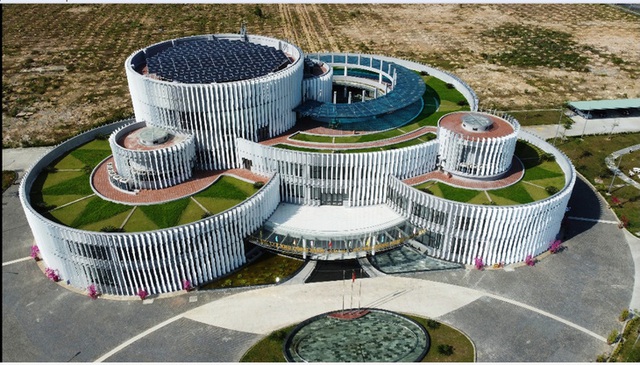Shaping tripolar for Vietnamese semiconductor industry development
VGP - Ha Noi, Da Nang and Ho Chi Minh City have already emerged as the tripolar to mastermind semiconductor technology as Viet Nam is on the way to seize opportunity to join global semiconductor supply chain.

An aerial view of Saigon High Tech Park in HCMC
* Ho Chi Minh City announced a US$5 million initiative to train 40,000 engineers by 2030, with plans to boost research, innovation, and technological capacity to accelerate its growth in the semiconductor industry.
The city targets to train 40,000 engineers in semiconductor design by 2030, setting up a US$5 million fund to support the development of a skilled workforce for the burgeoning microchip industry.
The Ho Chi Minh City People's Committee approved the "Semiconductor industry development program in the hi-tech park, 2025-2030," which aims to transform its hi-tech park into a national hub for semiconductor research and development.
The goal is to establish a robust ecosystem for semiconductor production that is equipped with cutting-edge infrastructure, modern governance models, and a highly qualified workforce capable of competing on an international scale.
The Ho Chi Minh City Hi-Tech Park is expected to become a center of excellence in semiconductor design, sensor development (MEMS), and advanced technology innovation. This ecosystem will attract large-scale investments and foster the creation of commercial products with high scientific value, contributing to the city's economic growth.
The program envisions the successful design and manufacture of high-powered electronic components such as MOSFETs and transistors for power control applications. The knowledge gained from this will form the foundation for the design and production of more complex semiconductor components in the future.
The city also plans to upgrade the Ho Chi Minh City Hi-Tech Park Business Incubator into a Center for Innovation, designed to cultivate a startup ecosystem for companies focused on semiconductor research and development.
As part of the initiative, the city is committed to producing at least 60 intellectual property (IP) assets related to semiconductor design, with plans to export these designs and core products internationally.
The metropolis will also enhance the facilities and expertise at the Hi-Tech Park to support semiconductor development projects, and will create partnerships with top experts and international specialists to ensure the highest standards in training and research.
By organizing short-term, transitional, and advanced training courses for at least 1,200 participants, and fostering collaborations with 2-3 international experts annually, the city aims to elevate its semiconductor industry to a global level.
This bold vision is part of the city's broader effort to drive technological innovation and economic development, positioning itself as a leader in the global semiconductor market by 2030.

Hoa Lac Hi-tech Park
*In Ha Noi, the Capital Law which was passed by the National Assembly this June, prioritizes semiconductor investment and offer various incentives from the local authorities. The law comes into effect on January 1, 2025.
Ha Noi prioritizes the Hoa Lac Hi-tech Park (HHTP) which serves as a hub for Viet Nam's leading information technology and telecommunications companies such as: Viettel, FPT, MobiFone, VinaPhone, CMC, Institute of Science, National Innovation Center (NIC), creating a thriving business community.
Experts regards this as an important advantage for Hoa Lac to develop high technology and soon become the "locomotive" of the national microchip industry.
In order to draw in significant investment projects, HHTP put in place a number of incentives. Businesses that invest more than VND4 trillion, or around US$170 million, for example, are now qualified for a 30-year corporate income tax exemption instead of the 15-year one that was previously offered.
The amended Capital Law, recently passed, now provides special incentives and support for the HHTP, such as technology incubation support and the application of a sandbox mechanism.
The HHTP Management Board is planning to roll out various social support policies to complement the existing financial incentives.

A bird’s-eye view of the Da Nang hi-tech park in Da Nang city
*The National Assembly (NA) passed and issued Resolution No. 136/2024/QH15 dated June 26, 2024, on the organization of urban government and the piloting of a number of specific mechanisms and policies for Da Nang's development, including preferential policies to encourage investment and development in the semiconductor and AI fields.
The Resolution provides special policies for the two fields, with Da Nang being the first to receive such benefits. Policies include personal income tax exemptions, training cost support, incentives to attract experts and scientists, and assistance in equipment procurement.
The central city is actively working to position itself as a semiconductor and AI hub of the future.
The city initiated semiconductor training programs, including a course for 25 university lecturers. It has also organized three engineer transition courses for 39 students and provided further training for 43 lecturers in the field.
Da Nang boasts 2,450 digital technology companies, with an average of 2.3 tech businesses per 1,000 people, or three-times the national average and ranking it second nationwide after Ho Chi Minh City. Its total digital workforce numbers 46,000 people.
Besides the three leading technology centers in the country, some other provinces such as Bac Ninh, Bac Giang are making efforts to invest in infrastructure, support businesses, and develop human resources to create a favorable ecosystem for the development of the semiconductor industry.
On September 21, Prime Minister Pham Minh Chinh signed Decision No 1018/QD-TTg, approving a strategy for the development of Viet Nam's semiconductor industry until 2050. Accordingly, between 2024-2030, Viet Nam aims to become a global center for semiconductor human resources and establish basic capabilities in research, design, production, packaging, and testing./.
